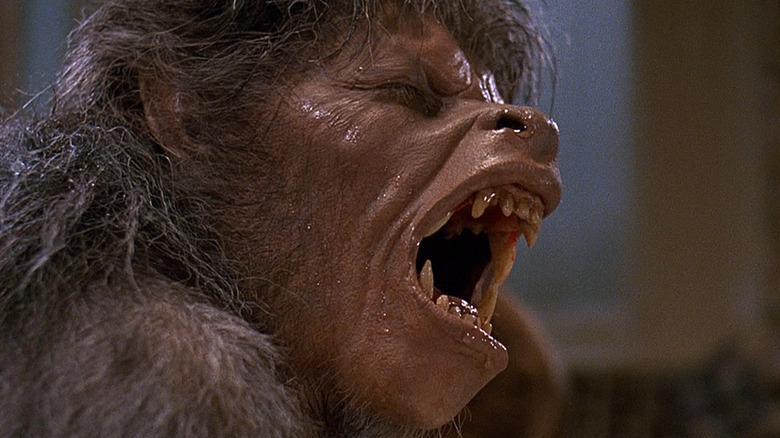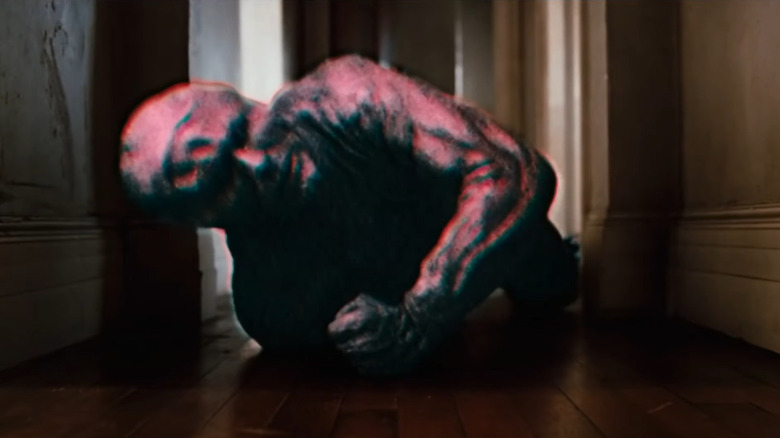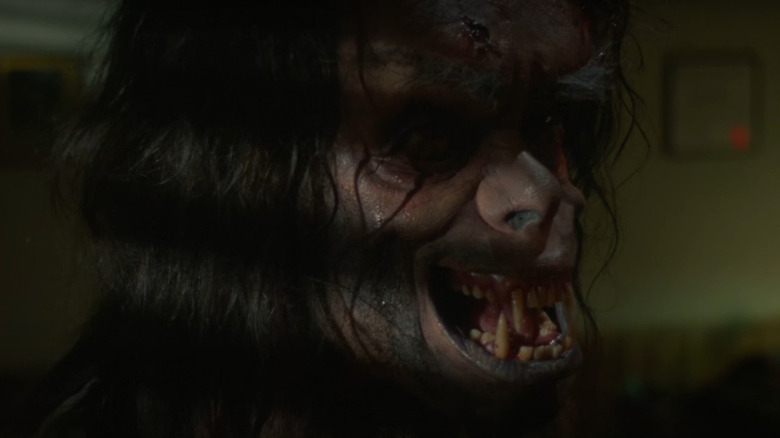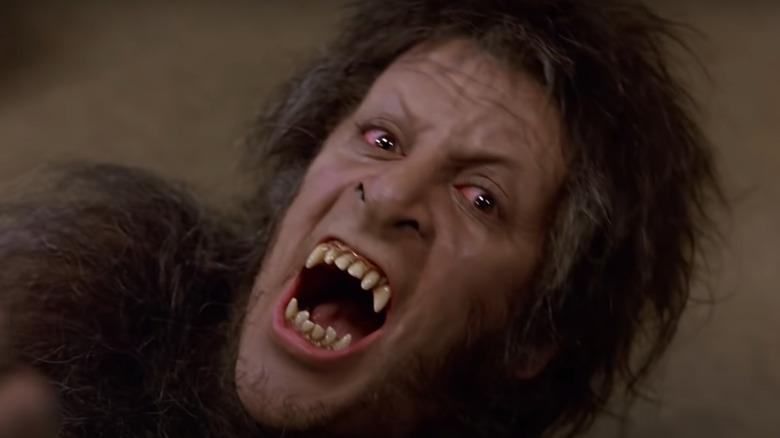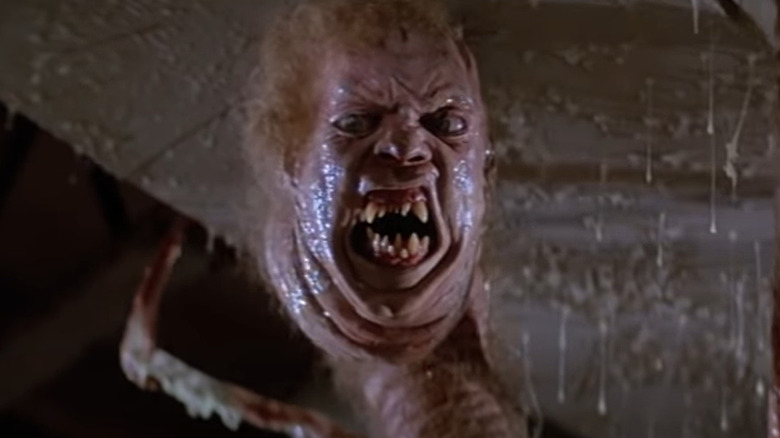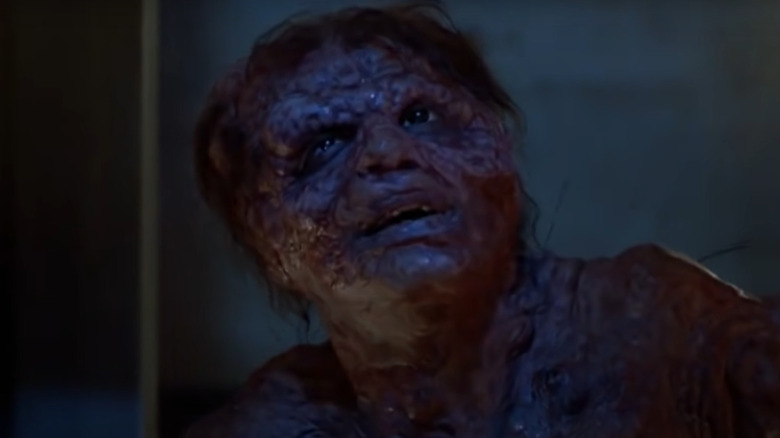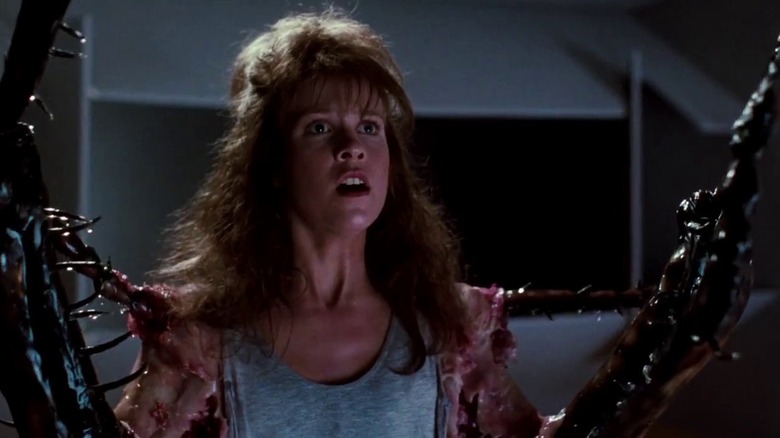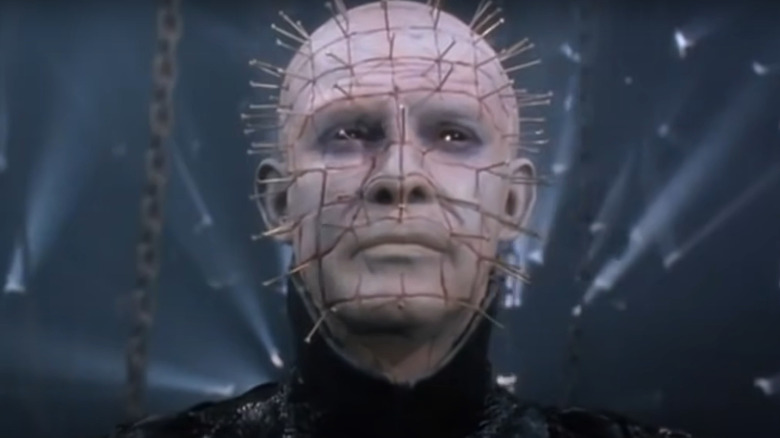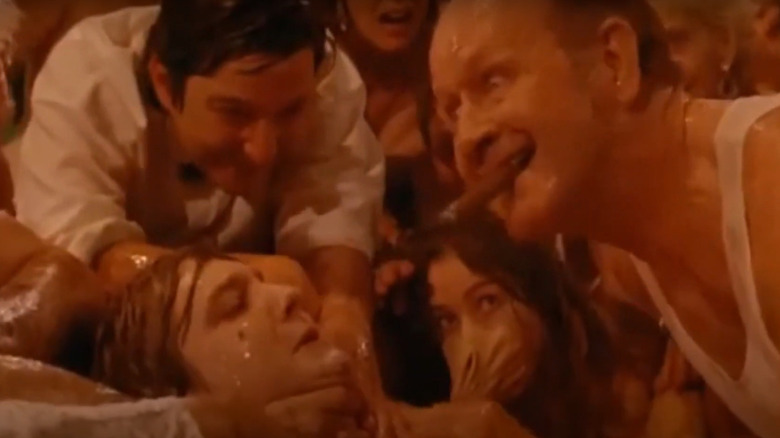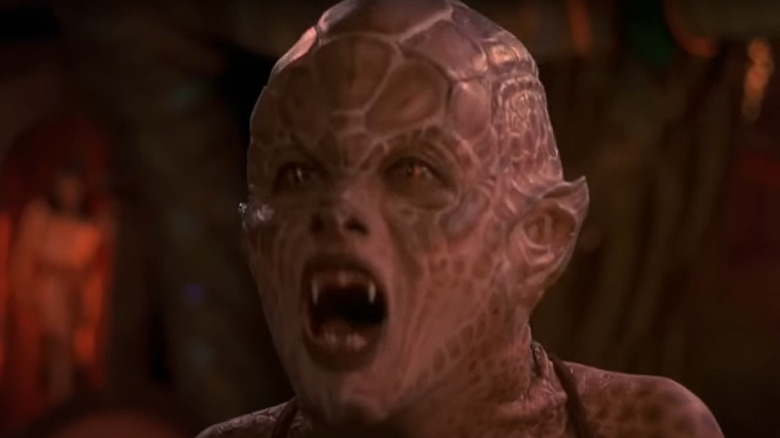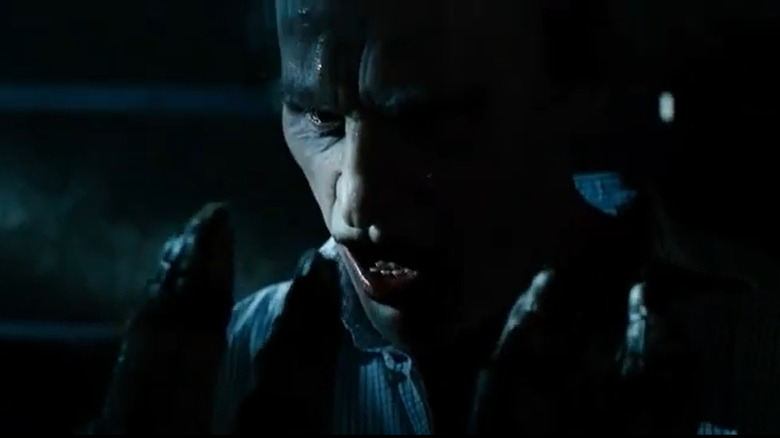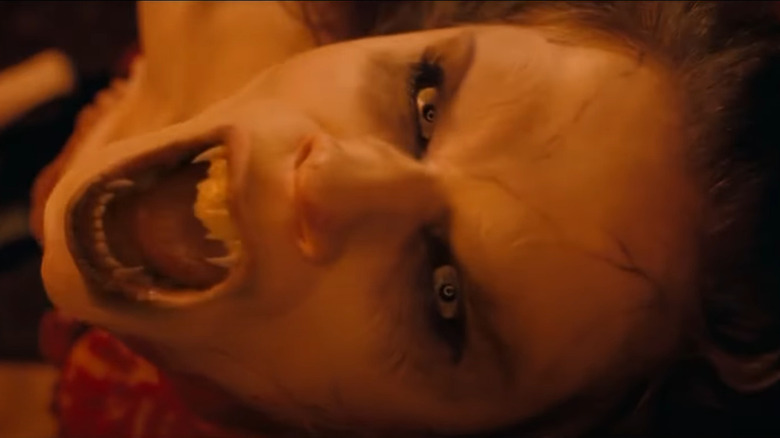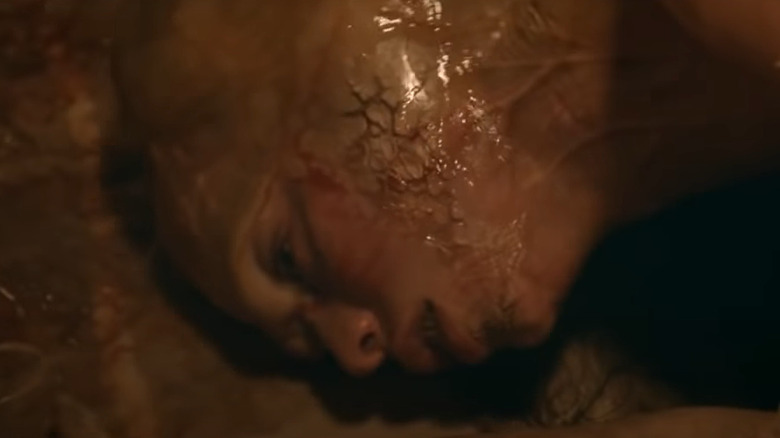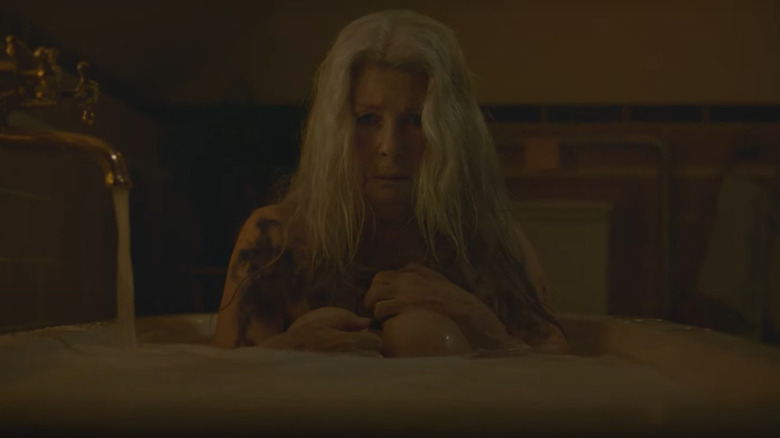Horror Movies With The Best Monster Transformation Scenes
We may receive a commission on purchases made from links.
Monster movies have been around for more than a century, with some of the earliest examples dating back to the formative years of cinema itself. Going all the way back to 1914's "The Golem" and 1922's "Nosferatu," monsters have been terrorizing moviegoers for decades and show no sign of going away. In fact, nearly every generation has suffered nightmares at the hands, claws, and jaws of silver screen creatures. The classic Universal monsters like Frankenstein, Dracula, the Wolf Man, and the Mummy dominated cinemas during the Golden Age of Hollywood; "Jaws" scared audiences away from the ocean in 1975 while "Alien" scared them away from space in 1979; and the special makeup effects innovations of the 1980s gave birth to a whole host of new drive-in monstrosities. It seems that no era is safe from a good creature feature.
The horror genre is filled with gruesome monsters that keep us coming back for more, even when they gross us out to no end. However, there's something that's extra memorable about seeing the transformation of someone into and/or from a monster, and innovations in makeup and visual effects allow filmmakers to constantly push the boundaries when it comes to showing us that ooey-gooey on-screen metamorphosis. In this article, we take a look at some of the best monster transformation scenes in horror movies.
(Warning: There are spoilers for each film mentioned in this article, as well as descriptions of violence and disturbing scenes.)
Altered States (1980)
"Altered States" was directed by Ken Russell and based on the Paddy Chayefsky novel of the same name. In his film debut, the late William Hurt plays Columbia University psychopathologist Edward Jessup whose work leads to experimenting with sensory deprivation in an isolation chamber in an effort to better understand other states of consciousness. In true mad scientist fashion, his studies take him to strange places, including a visit to the Hinchi tribe deep in the jungles of Mexico, where he tries some of their sacred plants to induce himself into a deep memory state. Satisfied with his "trip," Edward takes a sample back to the U.S. for further experimentation, and things only get weirder from there.
In the final transformation of the film, Edward's body begins to regress and devolve into a more primordial state, phasing back and forth across various forms. It's a wild sequence that uses the best of practical makeup and visual effects. Legendary makeup artist Dick Smith created an amorphous humanoid creature with deformed musculature, while Bran Ferren was behind the making of the pulsing energy effects emanating from Edward's body. The marriage of the two completely different approaches result in a hallucinogenic scene that was way ahead of its time and still looks great today.
The Howling (1981)
"The Howling" (recently given a 4K restoration) was directed by Joe Dante who's no stranger to helming creature features, as his credits include the original "Piranha," "Gremlins", and "Gremlins 2: The New Batch." Based on Gary Brandner's eponymous novel, the film tells the story of L.A. news anchor Karen White (Dee Wallace) who is sent to a forested resort to recuperate after a traumatic incident involving a stalker named Eddie Quist (Robert Picardo). However, Karen soon learns that the resort is actually a community of werewolves who can transform even without a full moon, and so she sets out to warn the world of their existence.
Hitting theaters just a few months before "An American Werewolf in London," "The Howling" features an almost-as-good transformation scene in which Karen is confronted by Eddie, who was seemingly killed earlier in the movie. While this transformation scene isn't quite as polished as that of "An American Werewolf in London," it still features some innovative effects for its time, replete with muscles bursting through clothing, monstrous teeth growing, and a face bulging and expanding. Interestingly enough, Rick Baker was the original makeup effects artist on "The Howling" until he left to work on John Landis' "American Werewolf," handing over the gig to Rob Bottin, who was an apprentice of his at the time.
An American Werewolf in London (1981)
"An American Werewolf in London" tells the story of two American backpackers, David and Jack, who are attacked by a werewolf while wandering around the North York Moors. Jack is killed while David survives, but because he was bitten by a werewolf, he is now cursed with lycanthropy. Throughout the film, David sees visions of his dead friend, who warns him that he's going to turn into a werewolf. David completely dismisses this, but soon realizes that he should've listened to Jack as he turns into a werewolf at the next full moon while staying at his lover's place in London.
And what a transformation scene it is! Never before had a film depicted the change from man to creature in such an intense and graphic manner. Fur sprouts from skin, bones bend and elongate, ears grow, and all kinds of other contortions of the human body are displayed in this legendary scene. Of course, the great special makeup effects artist Rick Baker was the man behind the creature work on "An American Werewolf in London", and would go on to win an Academy Award for his groundbreaking innovations, becoming the first recipient in the best makeup category. After this film came out, monster movies would never be the same again.
The Thing (1982)
Another remake of a classic 1950s sci-fi horror film, John Carpenter's "The Thing" tells the story of a group of researchers stationed in Antarctica as they are besieged by an alien entity that can absorb hosts and become them. With a claustrophobic setting and strong performances, the film increases the tension and paranoia in a way the 1951 original didn't, as each member of the doomed team question who's who and trust quickly turns into suspicion. Not only that, the group determines that if the alien were to reach civilization, it could assimilate the entire world population in a matter of months.
Like "The Fly," "The Thing" has more than its fair share of transformation scenes but one of the most iconic is when one of the team members named Norris (Charles Hallahan) suffers a heart attack and the others attempt to defibrillate him. However, it's quickly revealed that the stricken researcher is a copy when his chest bursts open in the shape of a large maw and a massive tentacled creature explodes out of it. The icky fun doesn't end there, as even when it's been torched with a flamethrower the head rips itself from the body and grows spider legs. There's plenty more that happens in this scene that this article can't do justice to, so just watch it for yourself.
The Fly (1986)
It should surprise no one that a David Cronenberg film would end up on this list, as the filmmaker spent much of his career singlehandedly giving birth to the body horror subgenre. This remake of the classic 1958 sci-fi horror flick follows scientist Seth Brundle (Jeff Goldblum) as he works on experiments involving teleportation that, of course, go horribly wrong. During one of Brundle's tests, a fly enters a teleportation pod with him and fuses their DNA. Because this is a Cronenberg flick, don't expect the scientist and the fly to simply swap body parts and spend most of the film trying to swap them back.
No, Brundle instead undergoes a gradual and way more disgusting evolution over the course of the film, involving such sights as teeth and nails falling out, skin growing boils and welts, and plenty of insectoid vomit. While there are multiple scenes of Brundle's change into something between a human and a fly, we've picked the final transformation scene in which the Brundlefly's skin falls off to reveal a horrible and slimy creature underneath. While fairly brief, it's nonetheless a powerful scene as Brundle's love interest is forced to watch him turn into an abomination of his own making.
A Nightmare On Elm Street 4: The Dream Master (1988)
This fourth installment in the popular "Nightmare On Elm Street" franchise is when the series began to drift away from the pure horror elements of the previous three movies, and towards a more darkly comedic style. The film follows Freddy Krueger (Robert Englund) as he returns to terrorize the surviving teens from the previous installment, "A Nightmare on Elm Street 3: Dream Warriors." However, he must now contend with Alice Johnson (Lisa Wilcox), who has been bestowed Kristen Parker's ability to bring other people into her dreams.
While not as fondly cherished as other entries in the "Nightmare On Elm Street" series, "The Dream Master" does have a few standout scenes, in particular one in which a sleeping Debbie Stevens (Brooke Theiss) is transformed into a giant cockroach. It's a gross-out scene, as gargantuan roach legs protrude from her skin and she soon finds herself inside a gigantic Roach Motel. When she falls onto the sticky floor, it rips her face off to reveal that of a human-sized cockroach. Debbie is then squished to death by Freddy, but not before he utters one of his classic sardonic one-liners: "You can check-in, but you can't check out!"
Hellbound: Hellraiser II (1988)
The 1987 cult classic "Hellraiser" introduced the world to one of the most iconic and perverse movie monsters in the horror genre: Pinhead. The film, written and directed by Clive Barker (which he based on his novel, "The Hellbound Heart") was successful enough to warrant a sequel Barker executive produced and wrote the story for. Taking place soon after the events of the first film, "Hellbound" focuses on Kirsty Cotton (Ashley Laurence) as she's put into a psychiatric hospital run by Doctor Channard (Kenneth Cranham), who's been searching for the Lament Configuration (the ancient device that opens the gateway to Hell and summons its Cenobites into our dimension) for years. Of course, Channard eventually gets a hold of the Lament Configuration, and all Hell breaks loose, so to speak.
At the beginning of the film, audiences are treated to a scene of World War I British Army Captain Elliott Spencer (Doug Bradley) as he opens the Lament Configuration and is graphically mutilated, ultimately becoming the mythical Pinhead. There are closeups of otherworldly razor blades cutting his head into the now-recognizable crosshatch pattern and metal pins rammed into each bloody intersection that's been carved into his head. It's an intensely brutal scene that serves as a reminder of the dangers that await those who wander too far into the regions of pleasure and pain.
Society (1989)
"Society" is one of the weirder films on this list, and that's saying something. Directed by Brian Yuzna (most famous for producing Stuart Gordon's H.P. Lovecraft flicks "Re-Animator" and "From Beyond"), the film tells the story of Bill Whitney (Billy Warlock), a teenager of a wealthy Beverly Hills family, who feels out of place with the upper-class community he lives in. He notices his family and girlfriend exhibiting strange and even disturbing behaviors, and eventually discovers that they are all of a different species from him.
As wacky as this darkly comedic horror satire is, the scene where Billy discovers the horrifying truth is the real standout. In it, he finds his family and their aristocratic friends engaged in a bizarre orgy that sees them all melding and fusing together, their bodies contorting and bonding into each other in disgusting ways. The over-the-top creature designs were done by Joji Tani, better known as Screaming Mad George, who is known to cult horror film fans for his surreal special makeup effects. It's a pretty long scene, the camera lingering on naked bodies warping and mutating in ways that only someone named Screaming Mad George could dream up, so don't watch if your heart is faint and your stomach is weak.
From Dusk till Dawn (1996)
Quentin Tarantino and Robert Rodriguez collaborated for the first time on this wild crime/horror film that follows the criminal Gecko brothers (played by Tarantino and George Clooney) as they force a former minister with his son and daughter to smuggle them into Mexico. The brothers are trying to get to a strip club in the middle of the desert where they will meet their contact, after which they promise to release the family. After some wild hijinks at the strip club, one of the Gecko brothers gets into a bar fight, revealing what's really going on at this place of ill repute.
You see, the dancers (and even the bar band) are actually vampires, and it isn't long before they all transform into their blood-sucking counterparts and begin feasting on the patrons. These aren't your classic vampires, which are basically regular humans with sharp teeth. In addition to the fangs, these vampires have distorted facial features, menacing talons, and even snake-like skin. What this scene lacks in intricate closeups of people turning into monsters it more than makes up for with a whole mass of people turning into monsters at the same time.
Black Sheep (2006)
Here's one more "were-" transformation scene, but at least it's not about a werewolf. No, this New Zealand comedy horror film gives new life to the genre with the creation of weresheep. "Black Sheep" begins in the past when brothers Henry and Angus Oldfield are children living on their farm with their father. However, when Henry experiences the dual shock of his father's accidental death and Angus pranking him with a sheep's corpse, Henry is left with a deep fear of sheep. Years later when they're both adults, Henry returns to the farm to sell his portion to Angus but discovers that he's been performing horrid experiments on sheep that turn them into vicious man-eating creatures. Even if you survive an attack from one, their bite can turn you into a grotesque human/sheep hybrid.
Angus eventually becomes a victim of his own aberrant scientific interests and is infected, leading to him mutating into Lamb Chop-meets-Mr.-Hyde. The transformation scene takes some of its cues from various classic monster transformations, featuring closeups of muscles protruding from clothing and the face extending into bizarre new proportions, all set to a soundtrack of cracking bones and distending limbs. If you're looking for a more modern creature flick that uses old-school practical makeup effects, then "Black Sheep" is for you.
Trick 'r Treat (2007)
The horror genre doesn't have too many non-linear films in its canon, making director Michael Dougherty's "Trick 'r Treat" unique for that reason alone. However, the anthology is more than a gimmick, as it consists of four separate storylines (plus an introduction and conclusion) that intertwine in clever ways on a Halloween night in the small town of Warren Valley, Ohio. One of the storylines revolves around a young woman named Laurie who's having trouble getting a date for a wild party out in the woods. She's later attacked by the school principal (who's got more than a few skeletons in his closet) but, in a surprising twist, he ends up being exactly what she was looking for.
As it turns out, Laurie's hunt for a "date" was really more of a hunt for a victim, who quickly learns that Laurie and her friends at the party are in fact werewolves. While including so many werewolf movies on this list may seem redundant, what other horror subgenre is as packed with awesome transformation scenes? Besides, "Trick 'r Treat" has a real wallop of a transformation scene, as multiple girls rip off their skin to reveal their true hirsute forms while chomping on their "dates" to the tune of Marilyn Manson's "Sweet Dreams (Are Made of This)." Admit it, it's a pretty cool scene, right?
Spring (2014)
H.P. Lovecraft wasn't known for being very tender, but he'd probably appreciate "Spring," a romantic horror film about Evan Russell (Lou Taylor Pucci), a young man who travels to Italy to help get over the recent loss of his mother. Once in Italy, he meets and develops a relationship with a mysterious woman named Louise (Nadia Hilker). As expected in this sort of film, there's far more to Louise than she lets on, and it's gradually revealed that she is thousands of years old. A member of an ancient primordial race, Louise also has the tendency to morph into a horrible monster on occasion, one of which is depicted when she's bothered by a tourist who makes the terrible mistake of believing her to be a prostitute before being murdered by her.
The real shock comes when Evan goes to Louise's home and stumbles upon a tentacled creature wearing Louise's dress and writhing around on the floor. The creature is obviously Louise, and upon realizing this Evan administers her a syringe filled with a concoction which helps Louise revert back to her human form, covered in slime and goo. The most disturbing aspect of this scene is that it depicts a creature that's caught between human and monster, something that's part homo sapien and part something else entirely.
Relic (2020)
"Relic" is the most dramatic of the horror films on this list, as it deals with the elderly Edna's bout with dementia, and the impact it has on her daughter Kay and her granddaughter Sam. Kay and Sam stay at Edna's house in the country to keep an eye on her but begin to realize that there's something else going on in the house that is affecting their aging matriarch. In addition to Edna's increasingly erratic behavior, Kay and Sam notice an unusual black mold growing around the house, as well as a mysterious bruise on Edna that resembles the mold.
Terror and tragedy come together in the emotionally wrenching climax as Kay slowly and lovingly peels away the skin and hair from her dying mother to uncover her true form: a feeble and decaying corpse breathing its last breath. The scene is disturbing in both a visceral and sentimental sense, since the camera lingers on every flesh-tearing gesture, contrasted with Kay's realization of what has been happening to her mother, as well as the revelation that this will be their final goodbye. Rarely has a transformation scene been so grisly and so heartbreaking at the same time.
